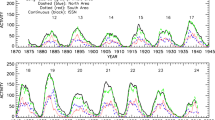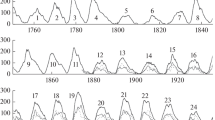Abstract
In addition to the Gnevyshev–Ohl rule (GOR), the relationship of an odd solar cycle with the subsequent even one in a 22-year Hale solar cycle was found. It is shown that three years before the 11-year minimum, the value of the relative sunspot number [SN] in an odd cycle is closely related to the value of the maximum in the next even cycle (the correlation coefficient \(\rho =0.94\)), and the same relation of an odd cycle with the previous even one is weaker. As in the GOR, cycles are linked in pairs, but when viewed in this way, the odd cycle is leading in the pair, opposite to the GOR. Based on this result, we propose to use the index of the third year before the minimum [\(S\!N_{\mathrm{m}-3}\)] on the descending phase of the previous odd cycle as a precursor of the subsequent even cycle. This method gives less reliable results for the prediction of an odd cycle or a prediction without consideration of parity (Brajša et al., Astron. Nachr. 343, e13960, 2022). To predict the amplitude of an odd cycle, we propose to use the seventh year before its maximum [\(S\!N_{\mathrm{M}-7}\)] on the descending phase of the previous even cycle. It turned out that, in this case, we can also predict years near the maximum with a high correlation coefficient (\(\rho =0.90\,\mbox{--}\,0.94\)). Thus, the proposed approaches allow us to predict cycles of different parity. According to our prediction, the current Solar Cycle 25 will reach a maximum at the turn of 2023 and 2024; the yearly mean SN in 2023 will be \(132\pm 27\) and in 2024 SN\(= 136\pm 25\). The maximum 13-month smoothed monthly mean SN will be \(149\pm 28\).






Similar content being viewed by others
References
Brajša, R., Verbanac, G., Bandić, M., Hanslmeier, A., Skokić, I., Sudar, D.: 2022, Astron. Nachr. 343, e13960. DOI.
Cameron, R., Schüssler, M.: 2007, Astrophys. J. 659, 801. DOI.
Clette, F., Svalgaard, L., Vaquero, J.M., Cliver, E.W.: 2014, Space Sci. Rev. 186, 35. DOI.
Clette, F., Cliver, E.W., Lefèvre, L., Svalgaard, L., Vaquero, J.M., Leibacher, J.W.: 2016, Solar Phys. 291, 2479. DOI.
Draper, N.R., Smith, H.: 1998, Applied Regression Analysis, Wiley-Interscience, New York.
Gmurman, V.E.: 1968, Fundamentals of Probability Theory and Mathematical Statistics, 1st edn. Elsevier, New York.
Gnevyshev, M.N., Ohl, A.I.: 1948, Astron. Zh. 25, 18. (In Russian).
Javaraiah, J.: 2017, Solar Phys. 292, 172. DOI.
Leamon, R.J., McIntosh, S.W., Chapman, S.C., Watkins, N.W.: 2021, Solar Phys. 296, 151. DOI.
Ludendorff, H.: 1931, Zeit. Astrophys. 2, 370.
McIntosh, S.W., Chapman, S., Leamon, R.J.: 2020, Solar Phys. 295, 163. DOI.
Nagovitsyn, Yu.A.: 2009, Astron. Lett. 35, 564. DOI.
Ohl, A.I.: 1966, Byull. Soln. Dannye Akad. Nauk USSR 12, 84.
Pesnell, W.D.: 2014, Solar Phys. 289, 2317. DOI.
Petrovay, K.: 2020, Liv. Rev. Solar Phys. 17, 2. DOI.
Slonim, Yu.M.: 1984, Byull. Soln. Dannye Akad. Nauk USSR 5, 78. (In Russian). ADS.
Svalgaard, L., Cliver, E.W., Kamide, Y.: 2005, Geophys. Res. Lett. 32, L01104.
Turner, H.: 1913, Mon. Not. Roy. Astron. Soc. 74, 82. DOI.
Vitinsky, Yu.I.: 1973, Tsiklichnost’ i prognozy solnechnoi aktivnosti (Cyclicity and Forecasting of Solar Activity), Nauka, Moscow. (In Russian).
Wilson, R.M., Hathaway, D.H., Reichmann, E.J.: 1998, J. Geophys. Res. 103(A4), 6595. DOI.
Zhu, H., Zhu, W., He, M.: 2022, Solar Phys. 297, 157. DOI.
Acknowledgments
We acknowledge usage of the sunspot data from the World Data Center SILSO, Royal Observatory of Belgium, Brussels.
Funding
This work was supported by the Programme of Large Projects of the Ministry of Science and Higher Education of the Russian Federation (grant No. 075-15-2020-780).
Author information
Authors and Affiliations
Contributions
All authors wrote the main manuscript text, prepared figures, and reviewed the manuscript.
Corresponding author
Ethics declarations
Competing interests
The authors declare no competing interests.
Additional information
Publisher’s Note
Springer Nature remains neutral with regard to jurisdictional claims in published maps and institutional affiliations.
Rights and permissions
Springer Nature or its licensor (e.g. a society or other partner) holds exclusive rights to this article under a publishing agreement with the author(s) or other rightsholder(s); author self-archiving of the accepted manuscript version of this article is solely governed by the terms of such publishing agreement and applicable law.
About this article
Cite this article
Nagovitsyn, Y.A., Ivanov, V.G. Solar Cycle Pairing and Prediction of Cycle 25. Sol Phys 298, 37 (2023). https://doi.org/10.1007/s11207-023-02121-w
Received:
Accepted:
Published:
DOI: https://doi.org/10.1007/s11207-023-02121-w




